Amman Food Tour: Discovering Jordanian Food
More than 90% of Jordanians are Muslim and I expect that our half day Amman Food Tour guide will be wearing a headscarf. Instead, Jumana tells me to look out for a woman wearing her hair in a ponytail and carrying a pink purse. Raised Catholic, a gold cross hangs from her neck.
Our Food and Culture Tour starts at the Citadel
I arrive at the gates of the Citadel, our meeting place, via a series of stairs. Amman was built on seven hills, over time expanding to cover nineteen hills and stairs are often the best way, if not the easiest, to get anywhere on foot. Half way up, I stop at a gallery and a lookout with a great view of the Roman Theatre.
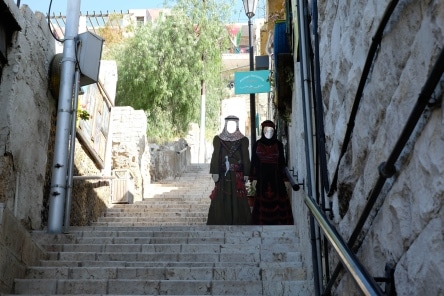

There’s little greenery. Occasionally a large colourful mural breaks up the bleak beige buildings. Sidewalks are cracked and there are many stray cats and kittens. Locals put out bowls of water and food to keep them from starving.
View from the Citadel
Built on one of the seven hills, the Citadel overlooks low-rise square buildings crowded on the hills opposite like different sized sandy blocks crowded together. On the flat roofs are numerous white plastic water tanks which Jumana says are filled once a week by the municipality.


Tall minarets, pierce the clear blue sky. When the amplified call to prayer interrupts our chat, Jumana explains how her father measured the distance from various mosques to decide where to buy his home.

People pour off busses and crowd around the entrance. The Citadel is the biggest historic site in Amman. I stand in awe and absorb the beauty of the Temple of Hercules. It dates back to 161 -166AD. People walk over the ruins, looking for the best ‘selfie’ angle.


Next Stop: The Roman Amphitheatre of Amman
On our way to the Roman Amphitheatre, Jumana teaches us how to cross the road “the Jordanian way”. It feels like I’m taking my life in my hands as I wait for a small break, step out with my hand signaling the oncoming cars to stop or at least give way. Later, when I explore independently, I’m pleased to know what to do, but I never step out without a lump of fear in my throat.
The Roman Amphitheatre looks small from our hotel window. It’s not. I feel dwarfed by the curved tiered seating rising way above my head. Jumana points out the sacrificial stone streaked with red, and the seat for royalty where a tourist rests their tired feet. I recall how gladiator’s lives hung in the balance as they waited for the royal signal. I always thought thumbs up meant the gladiator would be spared. Instead, I read that thumbs up meant death.


Jumana isn’t keen for me to follow the lead of other tourists and climb to the top of the three tiers of seating. She warns that the steps are slippery and uneven. After conquering one level, I’m happy not to go any further.
A group of young schoolgirls from Jordan’s south have surrounded BK, wanting to practice their English. One thinks carefully and then announces “I love you.”
The Food Tour of Amman Begins
We skipped breakfast and our tummies are rumbling as we enter the Souq Al-Sukar or Sugar Market. It’s close to Al-Husseini Mosque in Downtown (Old) Amman so named because sugar used to be stored here. As we enter, Jumana slips her cross out of view. She says that it’s just better that way. We walk single file down narrow passages between stalls laden with fresh fruit and vegetables, herbs, nuts and spices.
The Souq Al-Sukar or Sugar Market.
Every now and then, Jumana stops to point out ingredients and staples in Jordanian cooking. She chats and jokes with stall holders, saying “They’re my friends.” We taste lemon salt and pink cauliflower, halva and za’atar, which is “good for your throat in winter.”

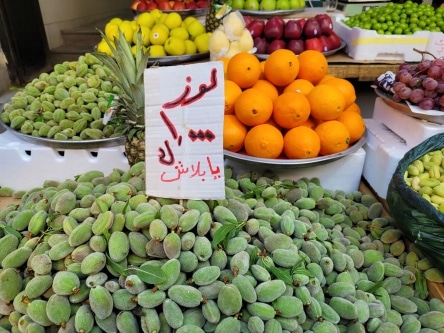
Green seems to be a theme. We try green almonds with salt. Biting into the hard and crunchy flesh, I avoid the slippery white immature nut. Green cherries, a local favourite in spring, taste bitter. Green chickpeas did nothing for me. A popular local drink juices limes with handfuls of fresh green mint.

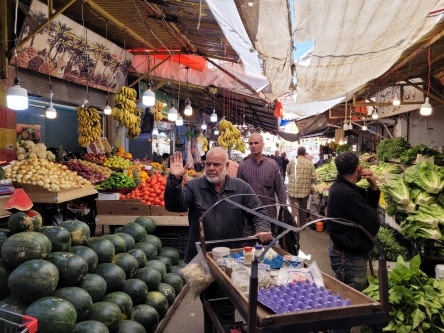
My eyes are drawn to pyramids of dates, some dried and slightly shriveled, others plump and juicy. Jumana explains that Jordanian dates are less dry. Their flesh is soft and sweet. I buy a bagful, adding to the smoked peanuts and apricot strap already in my stash of goodies.
Downtown Amman
Back in the streets of Downtown Amman, we pass jewellery shops displaying a huge range of elaborate gold jewellery. Jumana explains that when a man proposes, he must offer a full set (earrings, necklace, ring and bracelet) of gold jewellery as a sign of respect to the girl and her family. Not everyone can afford gold and a market for gold plated jewellery has sprung up.


Long black dresses decorated with red embroidered panels hang outside traditional clothing shops. Jumana has one and wears it on special occasions. Instead of the traditional hat, women and girls now often wear a headband with gold coins dangling across their forehead.
Jordanian flags hang from balconies and doorways and down tall building walls. They are there because Jordan recently celebrated ‘Flag Day’ and Independence Day isn’t far away.
The Serious Eating Begins
Before the serious eating starts, we stop at one of the many fruit juice stalls for freshly squeezed lime and mint juice. It’s refreshing and surprisingly sweet. I’m assured that sugar has not been added. Another day the language barrier means I make the mistake of buying a premade lime and mint juice served frozen from a clear plastic ‘barrel’. It’s awful. Sweet and seemingly filled with a cocktail of artificial flavouring.
Abu Zaghleh
We’re surrounded by locals at Abu Zaghleh, the first restaurant we visit. Before sitting down, we watch as rounds of flatbread dough are placed on the inside walls of a tabun, a round terracotta oven, to bake. Jumana tells us that in villages the woman who has two bread ovens is a rich woman. When others come to cook their bread in her ovens, the women share stories.


If the food served here is an example of what’s to come, we are in for a feast. The minced beef (keftah) with a generous drizzle of tahini and a few chips for good measure is delicious, but I particularly like the arayes. Meat seasoned with herbs is stuffed into flat bread with a splash of lemon. I’m hungry, but need to pace myself.
Hashem for Falafel
Jumana joins the queue at Hashem to order a falafel sandwich. Members of the Royal Family have been known to eat here and their photographs cover the walls. Popular with locals and visitors alike, there’s no menu, and you often have to wait for a seat, but service is fast and the food good.

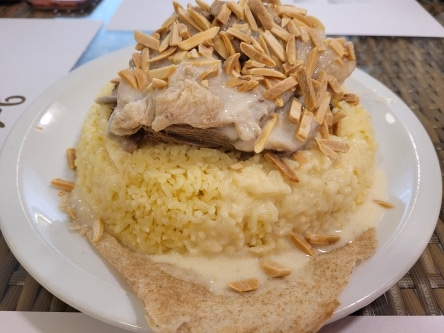
Jabri
Mansaf is the national dish of Jordan. We walk up the stairs of Jabri to enjoy the dish of goat meat, rice and reconstituted goats’ milk. Balls of dried goats’ milk, have been soaked and warmed. Jumana spoons the milk over the grey meat and faintly yellow rice. There’s no colour on my plate. This and the fact that I’ve already overeaten may be why the rich and creamy mansaf is less enjoyable than other dishes.
Our meal ends with Jordanian coffee spiced with cardamom. Pouring the coffee from a jug, she serves herself first. This is part of ‘coffee etiquette’ to show that there’s nothing wrong with the coffee and ensure that the coffee is sufficiently hot. She says that you should always accept coffee if offered to you, and indicate that you’ve had your fill by shaking your cup from side to side.
Knafeh from Habibah
It’s time for dessert from Habibah Sweet Shop. Their knafeh is so much better than anything I’ve eaten in Sydney’s Lakemba. With hot ghee spooned onto the dessert made with goats cheese melted between crunchy spun pastry drizzled with rosewater, the knafeh is sweet, rich and delicious.
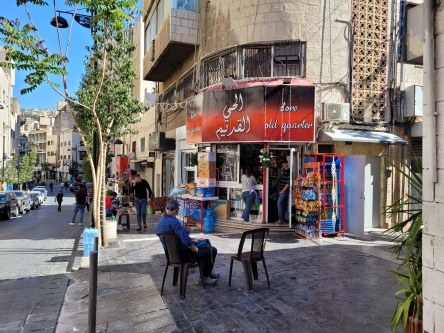
For a brief and much needed break from eating, we sip tea sitting roadside on black plastic chairs, watching the world go past. Jumana tells us about a famous hole in the wall, Reem, that sells shawerma, located on the ‘second circle’ near the Intercontinental Hotel.
Finding Reem (not on this tour)
Another day, we take a long walk to find Reem. On the way we discover a model of Amman in an administration building. Built around 2010, the model provides a good overview the city with the main street meandering through the valley passing through seven circles.

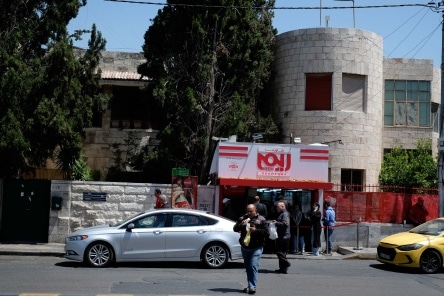
There’s a queue of taxi drivers waiting to order their shawerma at Reem. BK joins the queue. A man gives up his bench in the shade (the sun is beating down) on the inside of the circle for us. The shawerma is definitely worth the hype.
Traditional Ice Cream
Our last stop on the Amman Food Tour is for traditional ice cream. Made from full cream milk and saghlab, the ice cream is stored in big drums with open lids. The man at Bekdash holding a long handled wooden mallet vertically, rhythmically beats the air from the cold creamy dessert. I realise that the drumming sound I heard last night was from the ice creamery a couple of doors down from our hotel.
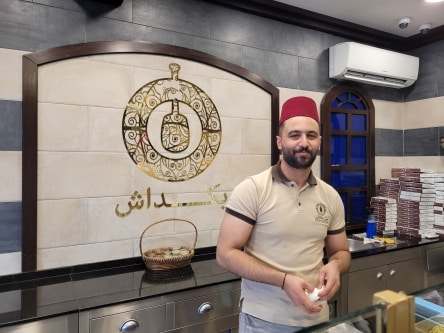
Jumana hands me a bowl of ice cream sprinkled with pistachio. It stretches almost like gum as I take a spoonful. The feel in my mouth is cloying, not too sweet and certainly morish. Three young men, obviously on a day out, emerge from the shop holding a polystyrene tray with a slice of knafeh topped with a large dollop of ice cream. They are looking for a sugar high. But then, who am I to talk after my indulgences this morning.
I’m pleased I joined this Amman Food Tour
Thinking that I know Arabic food, I hesitated to join this Amman Food Tour. I am so pleased I did. Jumana introduced me to dishes I had never tasted before and provided background to the dishes and Jordanian culture. Guide books can tell you only so much. A tour with a local enriches your experience.

Fascinating Jo!
Thanks, Lyn
Hi Joanne,
Thank you for your blog on Amman. I love middle eastern/Muslim food. A question: since this is a Muslim country, aren’t all women expected to wear the head scarf no matter what religion one practises? Your guide concealed her Christian crucifix……
I understand it’s a wise decision, but by not wearing a head scarf isn’t it obvious that the person isn’t a Muslim, hence consequences…..? Just an enquiry…..
Loretta
Interesting question, Loretta. No, as far as I know Iran is the only country where it is law to wear a head covering. Even in Saudi Arabia (I’ve just checked) and in other predominantly Muslim countries, women are expected to dress conservatively – covering arms, shoulders, legs etc. But I did see a woman in Amman in a short low cut red dress, exposed legs and exposed shoulders. I asked our guide why she hid her crucifix, and she replied “It’s just easier”, but it was on display the whole time at the Citadel.
This sounds like a wonderful tour. You are so lucky to have these interesting experiences!
Very lucky indeed, Charlene
I love that you started at the market. I bet most of the restaurants get their produce from that same market. Great that you got to try the best local food……it all looks very yummy.
So insightful, Bernadette. It’s obvious, but I never thought about the restaurants shopping at the market. Of course they must do.
Jumana still remembering you as one of the best travellers , I’m so glad you enjoyed that much and it seems you were listening very carefully , I’m so thankful that you were here and wishing you always the best ❤️
Always at your service